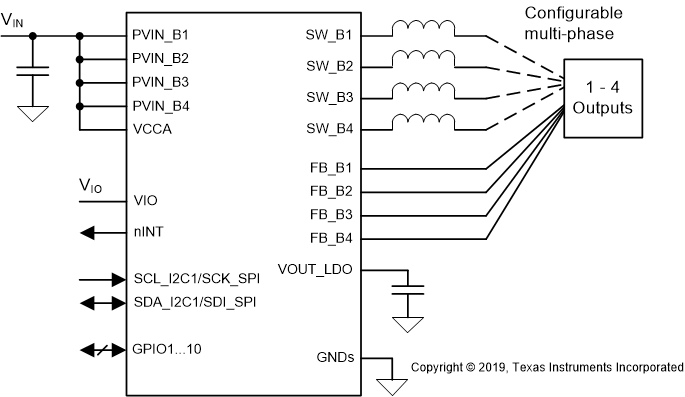ZHCSQ47 March 2022 LP8764-Q1
PRODUCTION DATA
- 1 特性
- 2 应用
- 3 说明
- 4 Revision History
- 5 Pin Configuration and Functions
-
6 Specifications
- 6.1 Absolute Maximum Ratings
- 6.2 ESD Ratings
- 6.3 Recommended Operating Conditions
- 6.4 Thermal Information
- 6.5 Internal Low Drop-Out Regulators (LDOVINT)
- 6.6 BUCK1, BUCK2, BUCK3, and BUCK4 Regulators
- 6.7 Reference Generator (REFOUT)
- 6.8 Monitoring Functions
- 6.9 Clocks, Oscillators, and DPLL
- 6.10 Thermal Monitoring and Shutdown
- 6.11 System Control Thresholds
- 6.12 Current Consumption
- 6.13 Digital Input Signal Parameters
- 6.14 Digital Output Signal Parameters
- 6.15 I/O Pullup and Pulldown Resistance
- 6.16 I2C Interface
- 6.17 Serial Peripheral Interface (SPI)
- 7 Typical Characteristics
-
8 Detailed Description
- 8.1 Overview
- 8.2 Functional Block Diagram
- 8.3 Input Voltage Monitor
- 8.4
Device State Machine
- 8.4.1 Fixed Device Power FSM
- 8.4.2
Pre-Configurable Mission States
- 8.4.2.1
PFSM Commands
- 8.4.2.1.1 REG_WRITE_IMM Command
- 8.4.2.1.2 REG_WRITE_MASK_IMM Command
- 8.4.2.1.3 REG_WRITE_MASK_PAGE0_IMM Command
- 8.4.2.1.4 REG_WRITE_BIT_PAGE0_IMM Command
- 8.4.2.1.5 REG_WRITE_WIN_PAGE0_IMM Command
- 8.4.2.1.6 REG_WRITE_VOUT_IMM Command
- 8.4.2.1.7 REG_WRITE_VCTRL_IMM Command
- 8.4.2.1.8 REG_WRITE_MASK_SREG Command
- 8.4.2.1.9 SREG_READ_REG Command
- 8.4.2.1.10 SREG_WRITE_IMM Command
- 8.4.2.1.11 WAIT Command
- 8.4.2.1.12 DELAY_IMM Command
- 8.4.2.1.13 DELAY_SREG Command
- 8.4.2.1.14 TRIG_SET Command
- 8.4.2.1.15 TRIG_MASK Command
- 8.4.2.1.16 END Command
- 8.4.2.2 Configuration Memory Organization and Sequence Execution
- 8.4.2.3 Mission State Configuration
- 8.4.2.4 Pre-Configured Hardware Transitions
- 8.4.2.1
PFSM Commands
- 8.4.3 Error Handling Operations
- 8.4.4 Device Start-up Timing
- 8.4.5 Power Sequences
- 8.4.6 First Supply Detection
- 8.5 Power Resources
- 8.6 Residual Voltage Checking
- 8.7 Output Voltage Monitor and PGOOD Generation
- 8.8 General-Purpose I/Os (GPIO Pins)
- 8.9 Thermal Monitoring
- 8.10 Interrupts
- 8.11 Control Interfaces
- 8.12 Multi-PMIC Synchronization
- 8.13 NVM Configurable Registers
- 8.14
Watchdog (WD)
- 8.14.1 Watchdog Fail Counter and Status
- 8.14.2 Watchdog Start-Up and Configuration
- 8.14.3 MCU to Watchdog Synchronization
- 8.14.4 Watchdog Disable Function
- 8.14.5 Watchdog Sequence
- 8.14.6 Watchdog Trigger Mode
- 8.14.7 WatchDog Flow Chart and Timing Diagrams in Trigger Mode
- 121
- 8.14.8 Watchdog Question-Answer Mode
- 8.15 Error Signal Monitor (ESM)
- 8.16 Register Map
- 9 Application and Implementation
- 10Power Supply Recommendations
- 11Layout
- 12Device and Documentation Support
- 13Mechanical, Packaging, and Orderable Information
1 特性
- 具有符合 AEC-Q100 标准的下列特性:
- 输入电压:2.8 V 至 5.5V
- 器件温度等级 1:–40°C 至 +125°C 环境工作温度范围
- 器件 HBM ESD 分类等级 2
- 器件 CDM ESD 分类等级 C4B
- 符合功能安全标准
- 专为功能安全应用开发
- 有助于使 ISO 26262 系统设计符合 ASIL-D 要求的文档
- 有助于使 IEC 61508 系统设计符合 SIL-3 要求的文档
- 系统可满足 ASIL D 级要求
- 硬件完整性高达 ASIL-D 级
- 窗口式电压和过流监控器
- 具有可选触发/Q&A 模式的看门狗
- 电平或 PWM 错误信号监控 (ESM)
- 具有高温警告和热关断功能的温度监测
- 对配置寄存器和非易失性存储器的位完整性 (CRC) 错误检测
- 4 个高效降压直流/直流转换器:
- 输出电压:0.3V 至 3.34V(多相位输出的电压为 0.3V 至 1.9V)
- 最大输出电流:每相位 5A,四相配置最高可达 20A
- 可编程输出电压压摆率:0.5 mV/µs 至 33 mV/µs
- 开关频率:2.2 MHz 或 4.4 MHz
- 10 个可配置通用 I/O (GPIO)
- SPMI 接口支持多个 PMIC 同步
- 输入过压监控 (OVP) 和欠压锁定 (UVLO)
 简化版原理图
简化版原理图